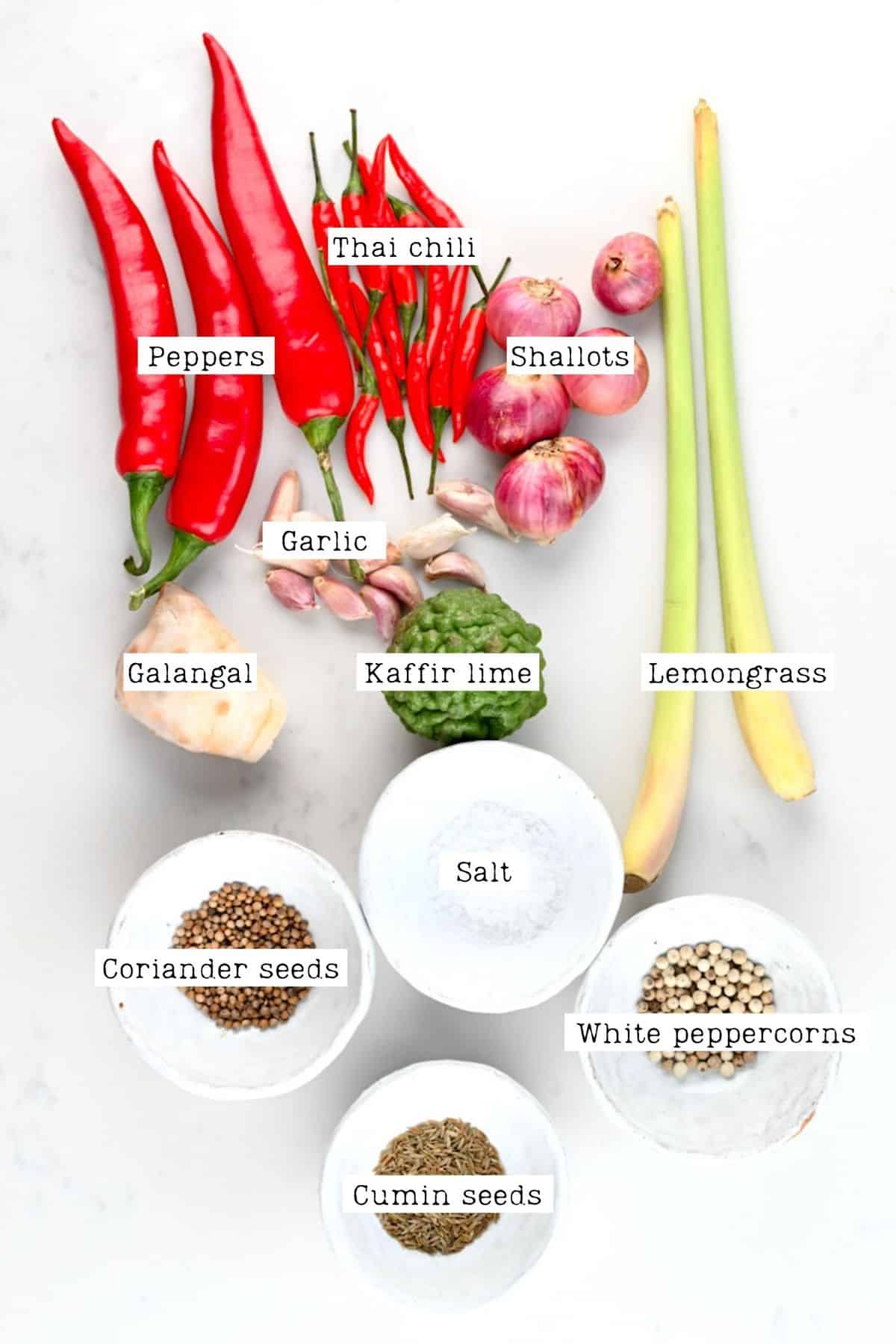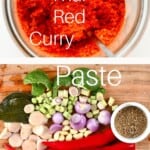This post may contain affiliate links. Please read our disclosure policy.
This Thai red curry paste (Prik Gaeng Ped) is flavorful, customizable, and takes just 5 minutes to prepare. Plus, this recipe can be made in bulk and frozen into portions for months of homemade Thai red curry!

I can’t believe that it’s been almost four months since I posted my Easy Thai Green Curry Paste recipe – which means this post is definitely overdue. While containing several identical ingredients, the two curry pastes are still worlds apart in flavor (and color), with this Thai red curry being a lovely shade of red, due to the addition of red peppers and chilies.
One of the best things about this Thai curry paste recipe, though, is its ability to be customized to your taste buds – meaning you can adjust the spice and quantity of different herbs and ingredients to your liking. The results are a Thai curry recipe that isn’t just ‘okay,’ but wows consistently!

After trying one too many store-bought Thai red curry sauces and pastes that I needed to adjust and adapt in order to enjoy, I realized that it would be best to make my own. I mean, if I’m going to the effort of having to add extra ingredients and experiment each time – then it renders the pre-made paste/sauce useless when it comes to making a low-effort, quick meal.
Instead, this curry paste can be made in bulk and frozen into portions, for whenever you want a low-effort mid-week meal. This red curry paste is also naturally gluten-free and vegan – omitting fish sauce or any seafood ingredient that some contain.
Want to save this recipe?
The Ingredients

- Sweet Red Peppers – This will help to reduce heat while still maintaining a strong red color. You can omit this, though, if you want a more pungent, spicy Thai red curry paste.
- Bird’s Eye Chili (Thai Chili) – You can’t have a traditional Thai red curry paste without Thai chilies! Feel free to start with a reduced amount and increase until you find your preferred level. You could also sub these with red Serrano peppers that are milder in heat and often used in Thai cuisine.
- Shallots
- Garlic
- Galangal – also called Siamese Ginger, this root looks a lot like Ginger but with a very different flavor. If you can’t find fresh galangal root, you may be able to find galangal paste or even swap it out with ginger/ginger powder.
- Kaffir Lime – If you’re unable to source kaffir lime, then you can use another lime variety, though it will affect the flavor. Lime juice levels will also differ from variety and individual limes.
- Kaffir Lime Leaves – Available in many grocery stores now – otherwise available at certain farmers’ markets and Asian food stores.
- Lemongrass – This may be available at larger grocery stores. If not, then Asian and Thai food stores are sure to have some.
- Cumin, coriander, and white peppercorn seeds plus salt
The Step By Step Instructions
Start by crushing the coriander seeds, white peppercorn and cumin seeds in your food processor or spice grinder.
Then, roughly chop the lemongrass stalks and galangal. Peel the lime – we are only using the green skin, so make sure not to peel too much of the white pith.

Add all the ingredients (sans spices) to a food processor or a blender. Blitz to break down to crumbs.
Add the spices and blend again until you achieve a creamy, smooth paste.

Taste and adjust this curry paste as needed. Practically every ingredient can be adjusted: add less/more chilies depending on what heat you want, more lime for extra acidity and zing, salt – for saltiness, and ingredients like the garlic, shallots, and galangal can be adjusted to personal taste.
Note* Remember though that the paste will be far more pungent than the final results at this point.
Once ready, store in an airtight glass container.

How To Store
The paste can be stored in a glass container for up to a week in the fridge. Alternatively, it can be frozen into individual portions in an ice tray and then transferred to a freezer-safe container for up to three months.
Note* I have actually successfully stored this in an airtight container in the fridge for up to a month, previously. However, I usually only keep enough in the fridge for a week so can’t guarantee freshness past that point.
How To Use
You can use this Thai red curry paste for a traditional Thai red curry (2 Tbsp per can of coconut milk, more if needed) served alongside fluffy Jasmine rice. Alternatively, this paste works well as a marinade, for sauces, salad dressings, stir-fries, soups, and more!
Let me know in the comments what your favorite ways of using it are!
Recipe Notes
- Though it will affect the color and consistency of the paste, you’re able to substitute many of the fresh ingredients for dried versions, if they are easier to source. For example, dried lemongrass and galangal can be used. However, you’ll need to adjust the amounts (I’ve found 1 tsp of dried to 1 Tbsp fresh is a good general conversion for these ingredients).
- You can add a little coconut sugar or maple syrup to the paste to balance out the heat. Start with 1/2 tbsp and add more if needed.
- Having made this recipe multiple times, I’ve found that the lemongrass can sometimes leave ‘stringy’ bits in the paste. While this doesn’t bother me generally, if you want to avoid this, then I suggest slicing the lemongrass thinly, against the grain, then adding the thinly sliced pieces to the blender and blending into a paste before adding the other ingredients.
- The type of sweet red pepper you use can affect the liquid content of the paste. i.e., red bell peppers tend to add quite a lot of liquid.
- If you find the paste to be a bit too thick, then you can add a little coconut oil or even water to thin the paste.
- You can start by lightly toasting the peppercorns, cumin, and coriander seeds in a pan for 3-5 minutes, until fragrant. Make sure to stir occasionally and don’t allow them to burn. I often skip this step, though, and I still love the results. Plus, if you’re using the spice powders, then this step can be skipped as well.
Related Thai Recipes
- Thai Inspired Vegan Green Pea Soup
- Creamy Vegan Thai Green Curry
- Easy Thai Green Curry Paste
- Easy Thai Red Curry (Vegetarian/Vegan Options)
- Thai Coconut Sweet Sticky Rice
If you try this recipe, then let me know your thoughts and any questions in the comments below. Also, feel free to tag me in your recreations on Instagram @AlphaFoodie.

Thai Red Curry Paste
Equipment
Ingredients
- 3 sweet red peppers
- 11 Bird's eye chili (Thai chili) more or less to taste. Alternatively, serrano peppers will work – though are less spicy
- 5 shallots
- 11 garlic cloves
- 1 galangal or paste/dried powder (reduce amount if using powder 1tsp dry per 1tbsp fresh)
- 1 Kaffir lime skin or other lime variety
- 2 kaffir lime leaves stems removed
- 2 lemongrass stalks or paste/dried powder (reduce amount if using powder 1tsp dry per 1tbsp fresh)
- 1 tsp salt
- 1 tsp cumin seeds or ground cumin
- 1 tsp white peppercorns or black peppercorns
- 1 tsp coriander seeds
Instructions
- Start by crushing the coriander seeds, white peppercorn and cumin seeds in your food processor or spice grinder.
- Then, roughly chop the lemongrass stalks and galangal.
- Add all the ingredients (sans spices) to a food processor or a blender. Blitz to break down to crumbs.Add the spices and blend again until you achieve a creamy, smooth paste.Taste and adjust this curry paste as needed. Practically every ingredient can be adjusted; add less/more chilies depending on what heat you want, more lime for extra acidity and zing, salt – for saltiness, and ingredients like the garlic, shallots, and galangal can be adjusted to personal taste.Note* Remember though that the paste will be far more pungent then the final results at this point.
- Once ready, store in an airtight glass container.
How To Store
- The paste can be stored in a glass container for up to a week in the fridge. Alternatively, it can be frozen into individual portions in an ice tray and then transferred to a freezer-safe container for up to three months.
Video
Notes
- Though it will affect the color and consistency of the paste, you’re able to substitute many of the fresh ingredients for dried versions, if they are easier to source. For example, dried lemongrass and galangal can be used. However, you’ll need to adjust the amounts (I’ve found 1 tsp of dried to 1tbsp fresh is a good general conversion for these ingredients).
- You can add a little coconut sugar or maple syrup to the paste to balance out the heat. Start with 1/2 tbsp and add more if needed.
- Having made this recipe multiple times, I’ve found that the lemongrass can sometimes leave ‘stringy’ bits in the paste. While this doesn’t bother me generally, if you want to avoid this, then I suggest slicing the lemongrass thinly, against the grain, then adding the thinly sliced pieces to the blender and blending into a paste before adding the other ingredients.
- The type of sweet red pepper you use can affect the liquid content of the paste. i.e., red bell peppers tend to add quite a lot of liquid.
- If you find the paste to be a bit too thick, then you can add a little coconut oil or even water to thin the paste.
- You can start by lightly toasting the peppercorns, cumin, and coriander seeds in a pan for 3-5 minutes, until fragrant. Make sure to stir occasionally and don’t allow them to burn. I often skip this step, though, and I still love the results. Plus, if you’re using the spice powders, then this step can be skipped as well.
Nutrition
Nutrition information is automatically calculated, so should only be used as an approximation.
















Will I be able to can (preserve in a sealed glass jar) this paste for my pantry?
Hi Ashlee! Yes, you can definitely can that paste in a sealed glass jar for your pantry but you do need to can it! Just make sure to follow proper canning procedures to keep it safe, I have the canning guide on the blog. 🙂
Could this paste be spread thin on parchment dehydrated and turned into a powder?
Hi Paul,
I don’t see why not. Make sure to dehydrate it at a low temperature so it doesn’t “overcook”.
Perfect simple delicious recipe! Thank you so much!
Thank you for your comment, Angelina 🙂
Yum
Thanks, Poppy!